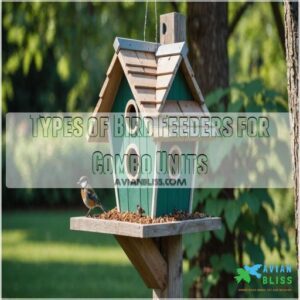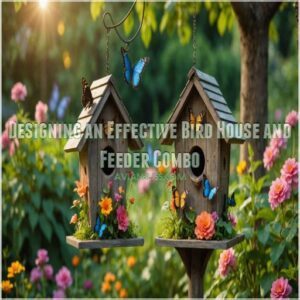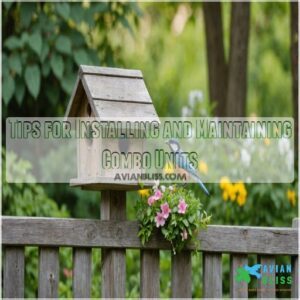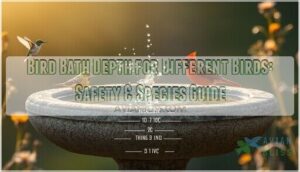This site is supported by our readers. We may earn a commission, at no cost to you, if you purchase through links.
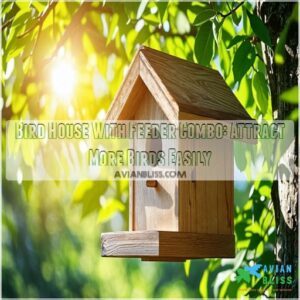 Transform your backyard into a vibrant bird paradise with a bird house with feeder combo.
Transform your backyard into a vibrant bird paradise with a bird house with feeder combo.
This nifty setup provides both a snug nest and a buffet for your feathered friends, making it a hotspot for avian visitors.
Choose a design that suits local bird species, considering entrance sizes and materials like cedar for durability.
These combos save space and offer a tidy solution for bird lovers.
You’ll enjoy watching a lively display as birds flit between feeding and nesting, all while keeping maintenance to a minimum.
Start this birdwatching adventure and discover the joys of a backyard symphony.
Table Of Contents
- Key Takeaways
- Choosing The Right Bird House
- Benefits of Combining Bird House and Feeder
- Types of Bird Feeders for Combo Units
- Designing an Effective Bird House and Feeder Combo
- Tips for Installing and Maintaining Combo Units
- Frequently Asked Questions (FAQs)
- What kind of bird house do birds like the best?
- Can you put a bird feeder next to a birdhouse?
- What color birdhouse attracts birds the most?
- What is the best combination of bird feeders?
- What materials are best for combos?
- How far apart should house and feeder be?
- Can I attract specific birds with combos?
- What about cleaning a combo unit?
- Are combo units predator-proof?
- Conclusion
Key Takeaways
- Transform your backyard into a vibrant bird paradise by choosing a bird house with a feeder combo, offering both nesting and feeding simultaneously.
- Make sure the bird house suits local bird species, considering entrance sizes and materials like cedar for durability and a bird-friendly environment.
- Position the bird house and feeder strategically to protect birds from predators and the elements, while maintaining easy access to water sources like bird baths.
- Reduce maintenance and enjoy more birdwatching by selecting weather-resistant materials and opting for a design that simplifies cleaning and refilling.
Choosing The Right Bird House
You’re about to start the rewarding journey of choosing the perfect birdhouse, and it’s simpler than choosing a pizza topping!
Just keep in mind the birds you want to attract, and think about their favorite designs and ideal placements to create a cozy, bird-friendly haven.
Attracting The Right Bird Species
To attract the right bird species, consider using a mix of feeder types like tube feeders and suet cages, match your bird house to your local winged wonders.
Consider each bird’s food preferences and nesting needs.
Installing a feeding station with a variety of bird food in your bird habitat can make your space irresistible.
Place feeders thoughtfully, and soon you’ll have a lively show of feathered friends chirping away!
Birdhouse Design Considerations
Designing the perfect birdhouse isn’t rocket science, but it’s important to get it right. Consider these factors:
- Entrance size matters; too big, and you’ll get uninvited guests. Check out DIY bird house plans free to determine the right entrance size for your desired bird species.
- Roof design is key for keeping the rain out and laughter in.
- Good ventilation with drainage holes makes sure your feathered friends have a comfy, dry home. Choose wisely, and watch your bird feeder combo spring to life!
Birdhouse Size and Shape
When choosing birdhouse size and shape, think about your backyard’s feathered guests.
Matching birdhouse dimensions and entry hole sizes to specific birds can boost your bird watching fun.
A slanted roof style helps with drainage, while proper placement offers safety from predators.
| Feature | Consideration |
|---|---|
| Birdhouse Dimensions | Match bird size |
| Entry Hole Size | Adapted to species |
| Roof Style | Ensure water runoff |
Birdhouse Materials and Durability
Several wood types offer excellent weather resistance, impacting your birdhouse’s lifespan and cost.
Cedar and redwood are naturally durable choices, resisting rot and decay.
Consider pairing your birdhouse with a feeder house combo from online stores like bird feeder combos.
However, pressure-treated lumber is cheaper but might require more maintenance.
Consider DIY options for a personalized touch!
Regular cleaning prevents pest infestations, extending your birdhouse’s life.
Remember, a well-built birdhouse is a haven for your backyard birds, attracting them with its sturdy design and weather protection.
Birdhouse Installation and Placement
Choosing the right spot for your birdhouse is where the real magic happens.
Think about height and direction—mount it high enough to avoid predators, perhaps on a pole or in a sturdy white pine.
Face the entrance away from prevailing winds.
Add a bird bath nearby for extra charm.
Multiple feeding areas can attract a variety of winged guests, enhancing your backyard’s avian allure.
Benefits of Combining Bird House and Feeder
By combining a bird house with a feeder, you create a welcoming environment that invites birds to stay longer while making your backyard a birdwatcher’s paradise.
Adding a bird house with feeder combo can also help attract birds like the Northern Cardinal and other species, by providing them with a convenient source of food and shelter, as seen in the various backyard birds of Indiana. You’ll also streamline your setup, saving both space and time, which leaves you more moments to enjoy the delightful antics of your feathered friends.
Increased Bird Attraction and Retention
Imagine setting up the perfect bird habitat, effortlessly making your backyard the go-to spot.
Combining a birdhouse with a feeder creates an ideal environment with abundant food sources and nesting materials.
This x-large attraction keeps birds coming back for more.
It’s like hosting a never-ending party, where birds feel safe from predators and enjoy cozy décor.
Convenience and Space-Saving Design
Ever wished for more space in your yard?
Combining a birdhouse and feeder provides both convenience and room to breathe.
You can find various combo bird feeder options online, such as those at Combo Bird Feeders, which cater to different needs and preferences.
With multi-feeder solutions, you can enjoy:
- Compact designs: Perfect for minimalist setups and yard optimization.
- Bird house placement: Easier decisions with one unit.
- By incorporating bird-friendly features like those found in guides for small birds in North Carolina, you can create a welcoming environment. Less clutter: Keep nature tidy while attracting more feathered friends.
Enhanced Bird Watching Experience
A birdhouse with a feeder combo transforms your backyard into a vibrant bird habitat!
You’ll enjoy watching varied bird behavior as they flutter between feeding and nesting.
With the best feeder placement, you’ll capture stunning moments – perfect for a camera setup.
Soon, bird identification becomes a playful game, making every glance an exciting part of your enhanced bird-watching experience.
Improved Bird Health and Well-being
By placing the bird feeder near natural cover like trees or bushes, as described in the bird feeder setup, pairing a bird house with a feeder creates a safe haven boosting bird health.
By combining these, you encourage disease prevention through proper feeder hygiene and safe food sources.
Birds enjoy a protected habitat, reducing stress and boosting well-being.
It’s like offering them the ultimate retreat!
You’ll see happier, healthier birds, all while maintaining a vibrant and lively garden.
Reduced Maintenance and Upkeep
Healthy birds mean less mess!
A combo unit simplifies upkeep.
You’ll spend less time:
- Cleaning – one location means easier cleaning.
- Refilling – combined feeders save you trips.
- Pest control – smart material choices deter unwanted guests.
Durable, weatherproof materials mean less worry, more birding!
Types of Bird Feeders for Combo Units
When choosing the right feeders for your bird house combo, you’ll find a delightful variety to suit every bird’s taste.
From seed and suet to nectar and berries, each feeder type plays a role in attracting different feathered friends, such as the Black-capped Chickadee and the American Goldfinch, which can be attracted by planting native fruiting shrubs, and don’t forget those pesky squirrels, you’ll want a feeder that keeps them at bay!
Seed Feeders and Seed Types
Consider your garden a cafeteria!
Are you choosing the best seed feeders and seed types?
Birds, like people, have different tastes.
You can find a bird house feeder combo for your garden, which can help attract more birds.
Here’s a quick guide in table form to start:
| Feeder Type | Seed Type |
|---|---|
| Tube | Sunflower seeds |
| Hopper | Mixed seed mix |
| Platform | Peanuts |
Storing seeds properly maintains freshness and keeps your feathered visitors happy!
Suet Feeders and Suet Options
Suet feeders are like the buffet of the bird world, especially in winter.
They offer high-energy snacks to feathered guests, providing sustenance when it’s chilly.
Try different suet recipe variations or even homemade suet for added benefits.
You’ll see more species flocking to your garden, enjoying these treats while you savor nature’s show right from your window.
Nectar Feeders and Nectar Types
Suet’s handled, but ever noticed those zippy hummingbirds?
They crave nectar feeders.
Mixing your own nectar recipe is a cinch—just sugar and water.
Pay attention to feeder cleaning to keep the little critters safe.
Store-bought nectar substitutes are available if you’re pressed for time.
Hummingbird species buzz around these feeders like bees to honey, making DIY nectar an entertaining project.
Fruit and Berry Feeders
Nectar might lure hummingbirds, but fruits and berries attract an even wider variety.
Mix up your garden buffet with fruit feeder types that suit different bird species.
Place berry feeders strategically for peak bird-watching, and get creative with DIY berry feeders.
Keep them clean, since nobody likes spoiled snacks.
You’ll find the fruit feeder benefits are truly berry enticing!
Squirrel-Resistant Feeders
You’ve laid out fruit and berry feeders, but pesky squirrels might crash the party.
Opt for squirrel-resistant feeders—your bird guests will thank you!
Consider models with clever baffles or try DIY squirrel guards for extra peace of mind.
Nail your feeder placement with insider tips, and explore the best squirrel-proof brands to enjoy a more harmonious backyard.
Keep those acrobat squirrels guessing!
Designing an Effective Bird House and Feeder Combo
You’ll create a bird haven by carefully considering placement, choosing materials that attract your target birds, and ensuring easy access to food and water.
Remember, a well-designed combo means happy birds and happy bird-watching for you!
Balancing Bird House and Feeder Placement
Positioning your birdhouse-and-feeder combo correctly can make all the difference. Consider these factors:
- Make sure birdhouse proximity to the feeder to give birds easy access.
- Adjust feeder height for visibility but keep it out of reach from predators.
- Utilize shade impact to keep the area cool and comfy, while also providing wind protection for stability.
Balance means happier, safer birds!
Considering Bird Species and Their Needs
When placing your birdhouse and feeder, make sure they suit the whims of local birds.
Each species has unique preferences—some want cozy nest boxes, while others look for specific food types.
Think of it as offering room service that fits their tastes!
Adjust for seasonal changes to keep your feathered friends coming back, filling your garden with song and color.
Choosing The Right Materials and Colors
Picking the right materials and colors for your bird house and feeder combo can make all the difference.
Natural materials like cedar are durable and blend in seamlessly with the surroundings.
Think about color psychology—earthy tones can help your bird house camouflage, making birds feel safe.
It’s like rolling out the welcome mat for feathered friends while showcasing nature’s palette.
Adding Water Sources and Other Features
Adding a splash of water can turn your bird house and feeder combo into a delightful oasis.
Place a bird bath nearby, ensuring easy access.
Opt for water sources like fountains or drippers—birds adore the sound of trickling water!
Don’t overlook shelter features like perches and plant covers.
They’ll create a safe and inviting retreat for feathered friends.
Maximizing Space and Minimizing Waste
Think of your bird house and feeder combo as a tiny, efficient apartment for your feathered friends, where you can utilize space-saving birdhouse designs, like using untreated wood for durability and bird safety birdhouses for small birds.
Design with smart bird feeder placement to reduce seed waste and guarantee efficient feeding.
Use clever seed storage ideas and easy waste cleanup strategies.
Picture birds chatting about their new home, perfectly shaped to maximize space while meeting their needs.
A win-win for everyone!
Tips for Installing and Maintaining Combo Units
Setting up your bird house with feeder combo just right can create a bustling bird hub, all while keeping things tidy and inviting.
With a little maintenance magic—like regular cleanings and careful placement—you’ll have feathered friends visiting in no time, and you might even find yourself becoming your neighborhood’s top avian hotspot!
Installing Combo Units in The Right Location
Now that you’ve designed your awesome bird house and feeder combo, let’s find the perfect spot!
Consider Location Factors like sunlight exposure – birds love a sunny spot for warmth.
Shelter protection from wind and rain is key.
Minimize Predator Risks by avoiding open areas.
Tree proximity offers a safe takeoff and landing.
Remember, a little planning goes a long way in creating a bird haven!
Maintaining Cleanliness and Hygiene
A spotless combo unit is key for happy, healthy birds.
Keep it gleaming with regular birdhouse cleaning and feeder sanitation.
This helps prevent diseases and pesky parasites.
Scrub the feeder with a gentle brush and soap, then rinse well.
Always practice safe handling by wearing gloves.
With these tips, your feathered friends will chirp with joy, and your efforts will soar!
Refilling and Replacing Feeders
Keeping your feeders freshly stocked and in tip-top shape is key to attracting more birds without breaking a sweat. Follow these simple tips:
- Set a cleaning schedule to prevent mold.
- Choose varied feeder types for diverse bird diets.
- Store your seeds in a dry, cool place for freshness.
- Use DIY solutions to simplify refills and replacements.
Monitoring Bird Activity and Health
After you’ve refilled your feeders, keep a keen eye on bird activity and health.
Watch for signs of avian flu and feeder diseases.
Pay attention to bird behavior: it can tell you plenty about population trends.
Conduct regular nest monitoring to make sure all is well.
Remember, a small observation today can prevent larger issues tomorrow.
Happy birdwatching!
Troubleshooting Common Issues and Problems
Even the best birdhouse and feeder combos face occasional hiccups. Regular maintenance can prevent small issues from becoming big problems.
- Feeder placement: Too close to windows? Birds might fly into them.
- Squirrel damage: Consider squirrel-proof designs.
- Birdhouse cleaning: Keeps unwanted guests at bay.
- Feeder maintenance: Refill and check for clogs.
- Bird health issues: Monitor for sick birds.
Frequently Asked Questions (FAQs)
What kind of bird house do birds like the best?
Birds love houses that mimic their natural environment.
Wooden constructions with ventilation and easy cleaning are ideal.
Make sure the entrance suits the specific bird species you wish to attract, like a cozy neighborhood rest stop for feathered friends.
Can you put a bird feeder next to a birdhouse?
Sure, you can!
To attract birds effectively, consider placing your bird feeder about 12 feet from bushes to prevent predator ambushes, as discussed in tips on where to place a bird feeder. Placing a bird feeder near a birdhouse is like having a snack bar next to a cozy home.
Just make sure there’s some distance to avoid disturbing nesting birds with frequent feeding activity.
What color birdhouse attracts birds the most?
What color whispers sweet nothings to the birdly heart?
Neutrals like brown, green, and gray often woo birds, blending seamlessly into nature.
Bold hues might repel them, so skip the flamboyant shades for feathered peace and quiet delight.
What is the best combination of bird feeders?
Imagine mixing a Squirrel Resistant Caged Tube Feeder with a Classic Hummingbird Feeder.
This dynamic duo offers seeds for small birds and nectar for hummingbirds.
Keeping your backyard lively and well-fed with a bird house and feeder combo can attract a variety of common Ohio birds, like the Northern Cardinal, Ohio’s most frequent backyard bird, your feathered friends well-fed.
What materials are best for combos?
Imagine this: choosing materials is like picking a dream team.
Opt for weather-resistant cedar or vinyl for durability.
These materials resist rot and harsh weather, keeping your feathered friends cozy and well-fed, come rain or shine.
How far apart should house and feeder be?
Place your birdhouse and feeder at least 10 feet apart to prevent territorial disputes and guarantee safety.
Birds will appreciate the distance for nesting peace, while you’ll enjoy watching them thrive in a friendly environment.
Can I attract specific birds with combos?
You can! Choose feeders and houses designed for specific bird species.
For example, a bluebird house attracts bluebirds.
Offering their favorite foods helps too! It’s like setting a delicious bird buffet.
What about cleaning a combo unit?
Imagine a cozy haven cleaned to perfection.
Remove food debris regularly, scrub the surfaces with warm soapy water, and rinse thoroughly.
Dry completely before refilling. This keeps the unit inviting for birds and deters mold.
Are combo units predator-proof?
Combo units, like birdhouses with feeders, aren’t generally predator-proof.
Ensuring bird safety means adding baffles or predator guards.
These simple tools can make a world of difference, keeping your feathered friends safe and sound.
Conclusion
Picture a backyard buzzing like an old-school jukebox.
By installing a bird house with feeder combo, you’ll attract a diverse flock of feathered guests.
It’s a win-win: birds get a comfy home and a tasty buffet, while you get endless nature entertainment.
This setup is practical, saving space and reducing upkeep.
Plus, you’ll boost local bird health by offering fresh food and shelter.
Get started on birdwatching bliss with your very own bird paradise!
- https://www.audubon.org/marketplace/birdhouses-feeders-and-accessories
- https://bettercrafter.com/collections/birds-sanctuary/birdhouse?srsltid=AfmBOopwl0o8e1mb6WPRQF7j50TRr-8bkoUY3dmrxF9TsxGAQrrSSxB5
- https://duncraft.com/products/rustic-farmhouse-galvanized-silo-combo-seed-feeder?srsltid=AfmBOooAn7DzuqJjLFRrNseVJ5NJqvPTQP_3T2kXi2sbrB4ODFxhBGt-



